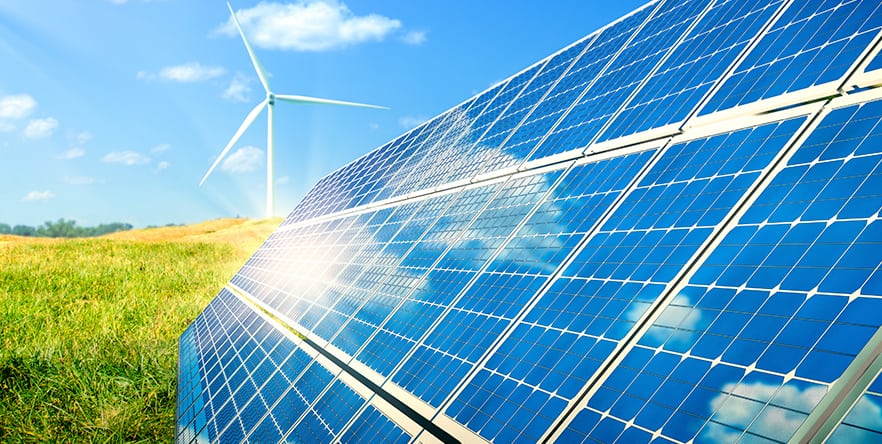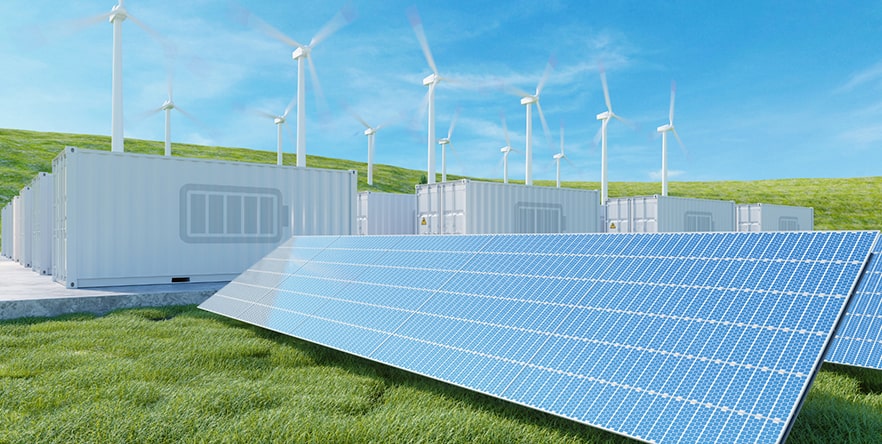Renewable Hybrid Power Plants
Consulting
Solutions


Similar to microgrids, renewable hybrid power plants have the capacity to generate and store enough electricity to power greater living areas. The integration of renewable hybrid power plants into communities, cities, and metropolitan areas is a fundamental component of any smart city. Projects of this nature can also be scaled to meeting growing demands of evolving city infrastructure and planning needs.
Grid Service Solutions
Grid services are a crucial part of any electrical grid. If the health of the electrical grid is not maintained black and brownouts can run rampant. See our grid service solutions below.
Inertia Emulation
- While penetration of renewable energy resources in the conventional power system provides many advantages such as power loss reduction, increasing spinning reserve and reliability of the power system, they also introduce new challenges to the power system.
- Conventional power systems mainly include huge synchronous generators that provide inertia to the system. This inertia is generated from the rotating mass of the generator called rotor. In fact, inertia is the kinetic energy stored in the rotor that can be utilized when the frequency of the power system is dropped. This inertia is used for frequency stability during critical times in the power system like sudden increase in demand or failing one generator. In this case, the system should react quickly and respond to the change properly to prevent frequency instability.
- Since renewable energy resources like solar panels don’t have rotating mass and are connected to the grid using power electronic converters, they don’t have inertia. Therefore, the amount of inertia is decreased by increasing the level of renewable energy in the power system as power system planners rely on these renewables for future development.
- The lack of inertia in the renewable energy resources can threaten the security of the power system.
- One main way to deal with this problem is to emulate the conventional inertia using power electronic converters.
- The idea of emulating conventional inertia is called “Virtual Inertia”.
- To realize the concept of virtual inertia, a control mechanism along with power electronic converters and an energy storage unit should be used. This controller can decide when to charge or discharge the battery when there is a change in the system such as sudden increase in the load or decommissioning a generator.
- Thus, renewable energy resources are capable of generating inertia using the concept of virtual inertia and participate in the frequency regulation.
- Another way to support the voltage is to install capacitor banks in the microgrid. Therefore, reactive loads like electric motors can utilize the reactive power stored in these capacitor banks. Not only does it support the local voltage, but it also reduces the electricity bill as local loads rely on local reactive power sources and they don’t draw reactive power from the upstream grid.
Duration of Storage: In the seconds or milliseconds of storage (minutes at most).
- Distributed generation is one of the main ways to support voltage at distribution busbars.
- Voltage in the power system is mainly affected by reactive power consumption.
- As the level of reactive power consumption is increased, the voltage is decreased.
- By generating reactive power locally through distributed generators like wind, solar and hydro, we can reduce the amount of reactive power absorbed from the upstream grid to support the busbars’ voltage.
Distribution Services
Technically, the capacity of transmission lines to transfer active power to the load side is decreased when the motor loads are increased. In fact, motor loads draw reactive power and this reactive power is fed from the power plants through the transmission lines. This reactive power, which is in the form of heat, decreases the capacity of active power transfer of the transmission lines. Locally generation on the load side is an effective way to reduce the power loss in the transmission lines. Distributed generators have been introduced to support the local loads and to decreed the power losses in the transmission lines.
Note: It can be easily deployed
Duration of Storage: Minutes to hours
Distribution Services
- Provide energy like kWh
- Standby ready to inject more energy into the grid
- Peak shaving
- Time shifting energy
- Managing the flow of power on the grid
Duration of Storage: Minutes to over 12 hours
Ancillary Services
Inertia Emulation
- While penetration of renewable energy resources in the conventional power system provides many advantages such as power loss reduction, increasing spinning reserve and reliability of the power system, they also introduce new challenges to the power system.
- Conventional power systems mainly include huge synchronous generators that provide inertia to the system. This inertia is generated from the rotating mass of the generator called rotor. In fact, inertia is the kinetic energy stored in the rotor that can be utilized when the frequency of the power system is dropped. This inertia is used for frequency stability during critical times in the power system like sudden increase in demand or failing one generator. In this case, the system should react quickly and respond to the change properly to prevent frequency instability.
- Since renewable energy resources like solar panels don't have rotating mass and are connected to the grid using power electronic converters, they don't have inertia. Therefore, the amount of inertia is decreased by increasing the level of renewable energy in the power system as power system planners rely on these renewables for future development.
- The lack of inertia in the renewable energy resources can threaten the security of the power system.
- One main way to deal with this problem is to emulate the conventional inertia using power electronic converters.
- The idea of emulating conventional inertia is called “Virtual Inertia”.
- To realize the concept of virtual inertia, a control mechanism along with power electronic converters and an energy storage unit should be used. This controller can decide when to charge or discharge the battery when there is a change in the system such as sudden increase in the load or decommissioning a generator.
- Thus, renewable energy resources are capable of generating inertia using the concept of virtual inertia and participate in the frequency regulation.
- Another way to support the voltage is to install capacitor banks in the microgrid. Therefore, reactive loads like electric motors can utilize the reactive power stored in these capacitor banks. Not only does it support the local voltage, but it also reduces the electricity bill as local loads rely on local reactive power sources and they don't draw reactive power from the upstream grid.
Duration of Storage: In the seconds or milliseconds of storage (minutes at most).
Distribution Services
Voltage Support
- Distributed generation is one of the main ways to support voltage at distribution busbars.
- Voltage in the power system is mainly affected by reactive power consumption.
- As the level of reactive power consumption is increased, the voltage is decreased.
- By generating reactive power locally through distributed generators like wind, solar and hydro, we can reduce the amount of reactive power absorbed from the upstream grid to support the busbars’ voltage.
Duration of Storage: Second to minutes
Transmission Services
Technically, the capacity of transmission lines to transfer active power to the load side is decreased when the motor loads are increased. In fact, motor loads draw reactive power and this reactive power is fed from the power plants through the transmission lines. This reactive power, which is in the form of heat, decreases the capacity of active power transfer of the transmission lines. Locally generation on the load side is an effective way to reduce the power loss in the transmission lines. Distributed generators have been introduced to support the local loads and to decreed the power losses in the transmission lines.
Note: It can be easily deployed
Duration of Storage: Minutes to hours
Capacity Services
- Provide energy like kWh
- Standby ready to inject more energy into the grid
- Peak shaving
- Time shifting energy
- Managing the flow of power on the grid
Duration of Storage: Minutes to over 12 hours
Talk to our team about the maintenance of a healthy grid today!
